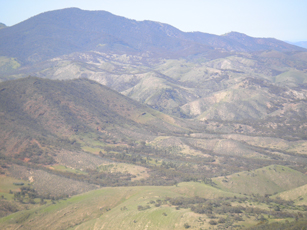Flinders chain
| Flinders chain | ||
|---|---|---|
|
The Flinders Range from Devil's Peak |
||
| Highest peak | St. Mary's Peak ( 1170 m ) | |
| location | South Australia | |
| part of | Australia | |
|
|
||
| Coordinates | 30 ° 55 ' S , 138 ° 37' E | |
| Age of the rock | Precambrian | |
|
The northern Flinders range in the satellite image |
||
The Flinders Range ( English Flinders Ranges ) is a mountain range in the north of the Australian state of South Australia (South Australia), which extends almost 500 km in a north-south direction. In this region are three national parks: Mount Remarkable National Park in the south, the Vulkathunha-Gammon Ranges National Park in the north and in the center is the Flinders Ranges its name to the Flinders Ranges National Park (Engl. Flinders Ranges National Park , a 912 km²) Nature reserve.
Geology and landscape
Geologically, the chain consists of Precambrian rocks that are up to a billion years old. Geological surveys were led by the Australian geologist and polar explorer Sir Douglas Mawson . They provided evidence that Australia was also affected by an ice age in the Precambrian, which perhaps had hit the entire globe ( Snowball Earth ). The Ediacara Hills are an important site of Precambrian fossils, the Ediacaran fauna .
Important elevations are Devil's Peak , Mount Remarkable, and St. Mary's Peak . The landscape is characterized by rugged low mountain ridges, deep gorges and sun-burned valley areas.
Flora and fauna
The eucalyptus- like tree River Red Gum ( Eucalyptus camaldulensis ) is typical of the park's flora . The entire flora has adapted perfectly to the irregular rainfall in the region. The inner walls of the Wilpena Pound are equipped with lush vegetation that otherwise occurs more in the south. The protected location and the milder climate make this possible.
33 out of 93 acacia species found in South Australia thrive in the Flinders Ranges. In the southern Flinders the vegetation is lush, because the relatively high amounts of precipitation and the varied terrain give the region a flora that is otherwise not found in this diversity and lushness in the Flinders. Casuarines, ferns and orchids grow here.
About 20 species of mammals live in the Flinders, including the human-introduced goats, rabbits, cats and foxes, all of which damage the flora and fauna. These animals are regularly shot down to preserve the native fauna. Different species of kangaroo live in the Flinders Ranges. Red kangaroos are predominantly at home on the open grassy plains. They come to graze in the moister valleys and are hardly bothered. The rare yellow-footed rock kangaroos are also native to this region, because the Flinders Ranges are one of the most important retreats for this kangaroo species in all of Australia. The rich bird life is concentrated in the cool ravines and at water holes, with over 100 species here represented. 50 species of reptiles also live in the region.
Archaeological finds
On the Warratyi rock overhang in the north of the mountain range, traces of human activity were found in 2016, the age of which was dated between 45,000 and 49,000 years. The overhang was first used from about 49,000 years ago, it experienced a high phase of use around 40,000 years ago and around 18,000 years ago. 35,000 years ago there was a clear temporary decline in use, which indicates a much drier climate at that time. The date of the first settlement is around 10,000 years before the previously accepted date for settlement of inner Australia. The site also showed that ocher was first used there 49,000 to 46,000 years ago, gypsum 40,000 to 30,000 years ago, stone tools 40,000 to 38,000 years ago, shaft tools 38,000 to 35,000 years ago and ornate works of art 30,000 to 24,000 years ago. These finds are the oldest of their kind in Southeast Asia and Australia and are each also 10,000 years older than the previously known finds. The site also shows that the people were in contact with the megafauna of the region, although it is unclear whether they went hunting or whether it is chance finds that were used.
See also
Web links
- Official site of the Flinders Ranges National Park (Engl.)
- Official site of the Mount Remarkable National Park (Engl.)
Individual evidence
- ↑ Nicola Davies, Humans arrived in Australian interior 49,000 years ago, archaeologists believe in: The Guardian , November 2, 2016, accessed November 3, 2016
- ↑ Giles Hamm, Cultural innovation and megafauna interaction in the early settlement of arid Australia , in: Nature , 2016, published online on November 2, 2016 doi: 10.1038 / nature20125



